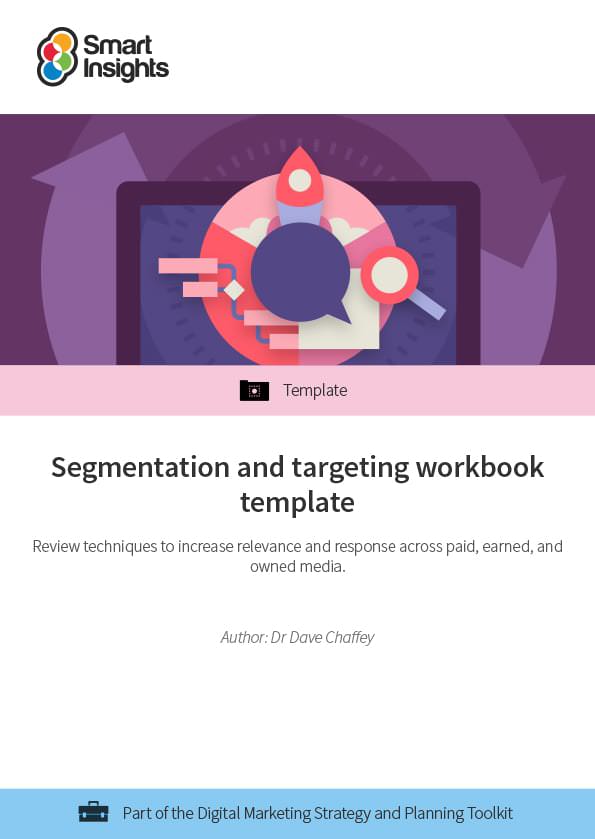Segmentation and targeting workbook template
Complete a strategic review of your digital targeting techniques across paid, owned, and earned media
How will this segmentation and targeting workbook template help me and my business?
One of the greatest benefits of digital marketing for businesses is the potential it offers marketers to deliver relevance. To improve the response of communications and gain better ROI, “relevance, relevance, relevance!” should be the mantra of marketers. Targeting options are available both through free, organic channels like email marketing and search engine optimization (via content marketing), but particularly through paid channels which use biddable media like Google Ads (including YouTube), and social media ad options including Facebook, Instagram, and LinkedIn.
However, using online targeting techniques is easier said than done because of the sheer number of targeting methods available to increase relevance, engagement, and response. That’s where this targeting workbook template comes in. It will help you complete a strategic review of your digital targeting techniques across paid, owned, and earned media.
Conducting a strategic audit is an essential part of a strategic approach to digital marketing. Completing the audit in this workbook will help make sure you’re not missing out on opportunities to increase relevance and response by creating a planned approach to testing new techniques.
Who is this template for?
This segmentation and targeting workbook is designed for those involved with creating marketing and digital marketing strategies and plans who want to improve their strategy and planning process. It will also help you if you’re involved ‘hands-on’ with managing a digital channel like the website, email marketing or biddable media. Roles who may find this workbook useful may include:
- Marketing directors and heads of marketing
- Digital marketing managers and marketing managers
- Customer acquisition managers and paid media/biddable managers
- Account managers in an agency working with clients to develop their media strategy
How is this template structured?
This download includes four Microsoft Word templates that you can modify for your business or clients which cover different types of targeting techniques. These include:
- Marketing persona quality review
- Online customer insight source review
- Targeting capability review for digital communications
- Checklist of biddable media targeting techniques for the main digital platforms
Resource Details
- Author: Dr. Dave Chaffey
- Editor: Amelia Cooper, Head of Content
- Format: Downloadable and editable Microsoft Word document
- Recommended related resources:
About the author
Dr Dave Chaffey
 Dave is co-founder of Smart Insights and creator of the Smart Insights RACE Planning Framework. He has consulted and trained for many businesses including large international B2B and B2C brands including 3M, BP, Barclaycard, Dell, Confused.com, HSBC, Mercedes-Benz, Microsoft, M&G Investment, Rentokil Initial, O2, Royal Canin (Mars Group) plus many smaller businesses. For his full profile, or to connect on LinkedIn or other social networks, see the About Dave Chaffey profile page on Smart Insights. Dave is author of 5 bestselling books on digital marketing including Digital Marketing Excellence and Digital Marketing: Strategy, Implementation and Practice. He has been recognized by the Chartered Institute of Marketing as one of 50 marketing ‘gurus’ worldwide who have helped shape the future of marketing.
Dave is co-founder of Smart Insights and creator of the Smart Insights RACE Planning Framework. He has consulted and trained for many businesses including large international B2B and B2C brands including 3M, BP, Barclaycard, Dell, Confused.com, HSBC, Mercedes-Benz, Microsoft, M&G Investment, Rentokil Initial, O2, Royal Canin (Mars Group) plus many smaller businesses. For his full profile, or to connect on LinkedIn or other social networks, see the About Dave Chaffey profile page on Smart Insights. Dave is author of 5 bestselling books on digital marketing including Digital Marketing Excellence and Digital Marketing: Strategy, Implementation and Practice. He has been recognized by the Chartered Institute of Marketing as one of 50 marketing ‘gurus’ worldwide who have helped shape the future of marketing.

 Paid Membership is required
Paid Membership is required








